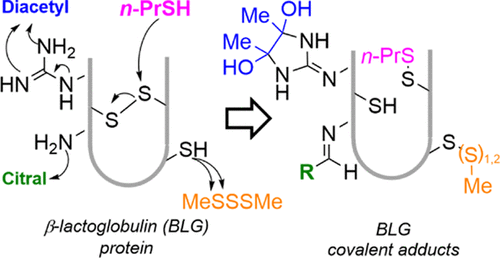Anantharamkrishnan, V.; Hoye, T. R.; Reineccius, G. A. J. Agric. Food Chem. 2020, 68, 6395–6402.
The formation of covalent bonds between 47 flavor compounds belonging to 13 different classes of functional groups and β-lactoglobulin (BLG) has been evaluated using electrospray ionization protein mass spectrometry. Covalent bond formation was determined by the appearance of ions in the mass spectra corresponding to BLG + flavor molecule(s). The observed processes for covalent bond formation were Schiff base, Michael addition, and disulfide linkages. Some reactions resulted in protein cross-linking. Aldehydes, sulfur-containing molecules (especially thiols), and functional group-containing furans were the most reactive flavor components. The thiol-containing compounds cleaved one or both electrophilic disulfide linkages in BLG to form disulfide linkages and the sulfides formed covalent bonds with the free cysteine group. Ketones were generally stable, but α-diketones (e.g., diacetyl) were reactive. Some bases (e.g., pyrazines and pyridines) were interactive, while the nucleophilic allylamine was reactive. Hydrocarbons, alcohols, acids, esters, lactones, and pyrans did not give observable levels of adduct formation within the period studied. The formation of covalent bonding (flavor protein) is potentially responsible for the loss of flavor, limiting the shelf-life of many foods.
